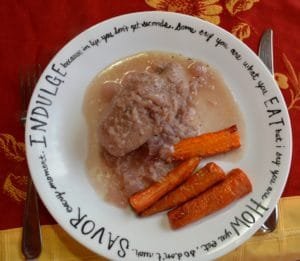Some time ago, I received the book British Food: An Extraordinary Thousand Years of History by Colin Spencer, and that I was intrigued to learn more about the eating habits of my homeland, particularly during medieval times. As soon as I read the book, I knew that I would have to try some of the medieval food dishes for myself.
The wonderful website Medieval Cookery provides a plethora of recipes based upon contemporary texts. Recipes are categorized by century, country, level of difficulty, and so on.

I started our 14th century meal with a Potage of Ris, a 14-15th century dish popular in England and on the continent.
2 cups milk
1/4 cup sugar
1 cup cooked white rice
a few almonds, crushed
pinch saffron
Bring the milk to a low boil and simmer until it has reduced to about 3/4 of its original quantity. Add the rice, saffron, and almonds. Warm through and serve.
Some versions also added some of the drippings from a meal’s meat, but I decided to keep mine simple and sweet. The result is a lightly sweetened rice pudding, with just a delicate hint of flavor from the saffron and almonds. The leftovers will be excellent as rice pudding with a dash of jam!
Next up is a meat course. The recipe called for Coney or rabbit. Unable to find rabbit, and thinking chicken a little too ordinary, I decided to go with duck. With the carcass and innards bubbling away in a pot to make stock (let’s not waste all that goodness), I set to work making Ducke in Civey.
4 lb duck, cut into breast, leg, wing, portions.
1 onion, chopped
2 tbs olive oil
1 cup red wine
2 cups chicken broth
1/2 tsp black pepper
1/2 tsp nutmeg
1/4 tsp ginger
a few whole cloves
1/4 tsp cinnamon
1/4 cup red wine vinegar
1/4 tsp salt
1 cup breadcrumbs
Sear the portions of duck in the heated oil. Remove the meat to a plate. Add the onion to the oil and saute until translucent. Then return your meat to the pan, along with the wine, broth, nutmeg, pepper, cloves, and cinnamon. Bring to a boil, and then cover and simmer for an hour.
In medieval times, sauces were often thickened with ground up livers or, as is the case here, with breadcrumbs. So when the dish has simmered nicely for an hour, stir in the breadcrumbs, red wine vinegar, and salt. Also take this opportunity to taste and add any additional spices, as required.
Some historians claim that nobles in the middle ages were not huge fans of vegetables and fruit with their meals, although this is contested by others so expect to see future posts on the topic. A few vegetable dishes I came across didn’t appeal to my modern palate (Composte being a dish of boiled root vegetables served cold in a sugary vinegar). As a compromise, I settled on simple, and added some roasted carrots to our plates.
I was a little surprised that the sauce was not redder, given the wine, and when cooking, I was concerned that the spices might be overpowering. Once again, though, the spices combined to provide a flavorful yet delicately spiced dish, and the duck was deliciously tender. After all, nobles in the Middle Ages had notoriously weak teeth, given their love of sugar. Meat was often ground or cooked to be very soft. Peasants, on the other hand, relied on a diet of vegetables and had wonderfully healthy teeth.

Finally to dessert and for this we did enjoy some fruit: Peeres in Confyt, better known as pears poached in red wine.
2 pears
1 1/2 – 2 cups red wine
water
1 cup sugar
1/2 tsp ginger
Peel the pears, but leave the stems intact. If necessary, slice a teensy bit from the bottoms so they stand up. Place in a pan with water and 1 cup wine, making sure the water covers the pears. Poach for about 30-40 minutes.
Boil the remaining wine with the sugar and ginger to make a syrup, which you serve over the pears.

All in all, the entire meal was surprisingly easy to prepare, very flavorful, and not at all out of place at a modern dining table. The flavors were sophisticated but never overpowering, and I look forward to creating my next medieval meal.



